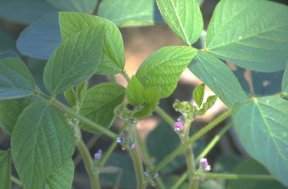Soy Greens—The Coming Health Food?
Soybeans have gained renown for offering a host of health benefits. Not only do diets rich in products made from this legume appear to protect against heart disease and some cancers, but they also help to preserve bones in aging bodies.

The best-established of these advantages is soy’s ability to lower blood concentrations of the so-called bad, or low-density-lipoprotein (LDL), cholesterol. However, data for this and soy’s other health benefits stem almost exclusively from trials that have administered soy’s seeds–or some isolated constituents of them–to animals and people.
Now, for those who eschew tofu or are tired of crunching soy nuts, Zhen-Yu Chen of the Chinese University of Hong Kong and his colleagues offer a decidedly different soy option: the greens. The researchers have demonstrated that the foliage’s chemistry is quite different from that of the soybeans. Yet their new data from experiments with hamsters indicate that the leaves themselves offer strong anticholesterol benefits.
Two benefits in one
In a study reported last year, the researchers first removed sections of carotid arteries from rats that were bred to spontaneously develop high blood pressure. In lab dishes, extracts of the soy leaves caused relaxation of the vessel walls. This suggests that the leaves contain something that might prove useful in counteracting hypertension in people, say the Chinese scientists. Interestingly, they note, the leaves don’t hold the isoflavones, such as genistein, that are primarily linked to the heart-protective effects of the bean.
Now the team has added dried soy-leaf powder or an alcohol-based extract of compounds from the leaves to the diets of young-adult hamsters for 4 weeks. This extra soy accounted for 3 percent of the rodents’ diet, by weight. At the end of the trial, the scientists ran extensive blood tests on the animals.
In an upcoming issue of the Journal of Agricultural and Food Chemistry, Chen’s team reports not only that the treatments lowered LDL and related bad cholesterols, but also that they elevated the so-called good, or high-density-lipoprotein (HDL) cholesterol. The latter is especially difficult to do by only adjusting a person’s diet. Usually, a person with unhealthy cholesterol readings needs to increase exercise, lose weight, and stop any cigarette smoking to increase his or her HDL cholesterol.
The dried leaves increased HDL cholesterol in the hamsters by not quite 2 percent–the extract, by almost 10 percent–when compared with HDL in animals eating soyfree versions of the same diet. The dried leaves also dropped LDL and related unhealthful cholesterols by 12 percent; the extract, by almost 9 percent.
As with relaxation in the carotid artery, the scientists aren’t sure what compounds in the leaves account for these encouraging cholesterol changes. The leaves are rich in antioxidants that weakly mimic the female sex hormone estrogen: several kaempferol glycosides and an isoflavone known as genistin. But those compounds don’t appear to explain the effect, Chen says. It’s also clear, he told Science News Online, that the plant’s fiber isn’t responsible, since the fiberfree extract worked.
With roughly 75 million acres of U.S. farmland devoted to production of soy’s beans, there’s plenty of foliage available to augment the nation’s salad bars. The only question may be whether people will want to top a plateful with a low-fat ranch, French, or vinaigrette.







